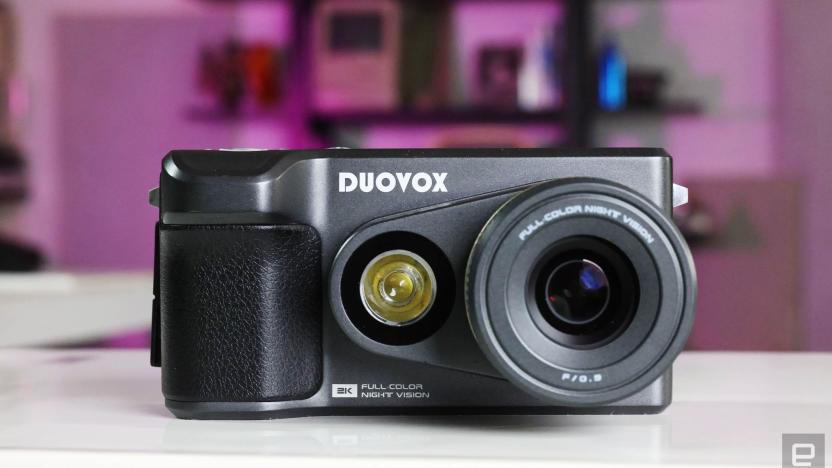near-infrared
Latest

DuoVox Mate Pro: A fun but imperfect night vision camera
The DuoVox Mate Pro features a Sony STARVIS 2 CMOS surveillance camera sensor that’s a thousand times more sensitive than the latest smartphone sensors.

NASA gives away the data from an Earth-mapping spacecraft
Want to know a whole lot about the Earth's surface? NASA and the Japanese government are now giving away all the data from the ASTER (Advanced Spaceborne Thermal Emission and Reflection Radiometer) instrument... for free. Previously, you had to pay if you wanted anything more than basic topographical maps; now, you get over 16 years' worth of near-infrared elevation and thermal data. This is mostly helpful if you're a student or a scientist, but it could be worth a peek if you've wanted to see how everything from farms to volcanoes can affect the planet's surface heat.

Near-infrared dye helps doctors spot cancer
Doctors regularly use dyes to highlight blood vessels that would normally be hard to see, but there's now the possibility that they'll use those chemicals to find cancer, too. Stanford researchers have developed a medical dye that emits light at a near-infrared wavelength, which produces sharper images that are visible at deeper skin layers. That, in turn, would let health care workers detect near-the-surface tumors such as breast cancer and melanoma. It leaves the body within a day, so you wouldn't have to worry about any long-term effects.

Sharp's night vision camera records color even in total darkness
Say goodbye to the days of monochrome night vision footage, folks. Sharp recently unveiled an infrared security camera that captures color 720p video, even in absolute darkness. The trick is an imaging sensor that uses near-infrared for illumination; unlike virtually every other competitor, this camera doesn't have to resort to conventional lights (and thus give itself away) to get a vivid picture. It's based on tech we've seen before, developed by Japan's National Institute of Advanced Industrial Science and Technology (check out some video from a 2011 demo embedded after the break.) The device will likely be limited to corporate and government customers when it goes on sale in late November, but it could have a big impact on your safety. Building managers will soon have an easier time identifying intruders, not just spotting them -- while the technology might not stop a break-in, it should increase the chances of catching thieves before they strike again.

Hawaii clears land use for the Thirty Meter Telescope, construction to start in 2014
The Thirty Meter Telescope has been under development for more than a decade, but the sheer amount of land needed on Hawaii's Mauna Kea for its namesake main mirror has proved problematic: locals have formally challenged the multi-university effort over concerns that it might damage both the environment and natives' heritage. Regardless of which stance you take on the issue, the project is going forward now that the state's Board of Land and Natural Resources has granted an official land permit. The move clears an optical and near-infrared telescope with nine times the coverage area of its peers, and three times the sharpness. That's enough to observe light from 13 billion years ago as well as put a heavy focus on tracking extrasolar planets, including planets in the making. Any impact on science or Mauna Kea will have to wait when construction doesn't even start until April 2014, although we're hoping that environmental care requirements attached to the permit will let us appreciate both the early universe and modern-day Earth in equal measure.

Visualized: Cassini probe gets a glimpse of Saturn's shadow
The Cassini space probe has collected quite a few memories of Saturn in its eight years, swinging by the planet's moons and even listening to lighting storms. Even so, we're being treated to an uncommon sight today: the dark side of Saturn. A newly processed set of 60 images, originally taken in October, shows what the gas giant is like from near the center of its shadow. The slightly trippy color scheme stems from a mix of visible, near-infrared and violet light in the collage. Sitting in the darkness allows for more than just pretty pictures, as well -- it reveals details about Saturn's atmosphere and rings that would otherwise be obscured by sunlight. Just be sure to etch this mosaic in your memory. The last time Cassini had an opportunity for this kind of snapshot was in 2006, which rules out any quick retakes.

Harvard makes distortion-free lens from gold and silicon, aims for the perfect image (or signal)
Imaging has been defined by glass lenses for centuries, and even fiber optics haven't entirely escaped the material's clutch. Harvard's School of Engineering and Applied Sciences might have just found a way to buck those old (and not-so-old) traditions. A new 60-nanometer thick silicon lens, layered with legions of gold nanoantennas, can catch and refocus light without the distortion or other artifacts that come with having to use the thick, curved pieces of glass we're used to -- it's so accurate that it nearly challenges the laws of diffraction. The lens isn't trapped to bending one slice of the light spectrum, either. It can range from near-infrared to terahertz ranges, suiting it both to photography and to shuttling data. We don't know what obstacles might be in the way to production, which leads us to think that we won't be finding a gold-and-silicon lens attached to a camera or inside a network connection anytime soon. If the technology holds up under scrutiny, though, it could ultimately spare us from the big, complicated optics we often need to get just the right shot.

All-carbon solar cell draws power from near-infrared light, our energy future is literally that much brighter
What's this orange-like patch, you ask? It's a layer of carbon nanotubes on silicon, and it might just be instrumental to getting a lot more power out of solar cells than we're used to. Current solar power largely ignores near-infrared light and wastes about 40 percent of the potential energy it could harness. A mix of carbon nanotubes and buckyballs developed by MIT, however, can catch that near-infrared light without degrading like earlier composites. The all-carbon formula doesn't need to be thickly spread to do its work, and it simply lets visible light through -- it could layer on top of a traditional solar cell to catch many more of the sun's rays. Most of the challenge, as we often see for solar cells, is just a matter of improving the energy conversion rate. Provided the researchers can keep refining the project, we could be looking at a big leap in solar power efficiency with very little extra footprint, something we'd very much like to see on the roof of a hybrid sedan.

New high-res imaging could make biopsies obsolete, doctors still cutting up in meantime
So maybe a true-to-life Innerspace is still a few years off, but a professor at the University of Rochester has developed a way to take high-resolution 3D images under the skin's surface, potentially eliminating the need for biopsies in cancer detection. Professor Jannick Rolland created a prototype that uses a liquid lens, in which a droplet of water replaces the standard glass lens, in conjunction with near-infrared light, to take thousands of pictures at varying depths. Those images are then combined to create clear, 3D renderings of what lies up to one millimeter below your epidermis. The method has already been tested on livings beings, but is likely a long way from making it to your doctor's office, which means it's off to the guillotine for that Pangaea-shaped mole you've been picking at.

Venus wearable monitor could offer alternative to needles
It looks like folks wary of needles now have yet another piece of technology to look forward to, with this so-called Venus device promising to measure tissue oxygen and pH levels without the need to draw any blood at all. To do that, the system makes use of a relatively small sensor that's placed directly on the skin, which uses near infrared light to measure to measure the blood and analyze both the tissue oxygen and pH, as well as the the metabolic rate. As a bonus, the lack of needles also reduces the the risk of infection, and it's relatively portable nature makes it ideal for use outside of strictly medical situations, such as monitoring athletes -- or astronauts, as it was originally developed for. As you might expect, however, the device is still just in prototype form, and there doesn't appear to be any indication as to when it might move beyond the lab.



